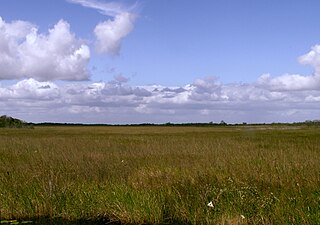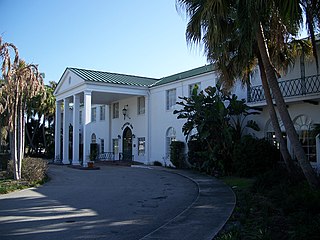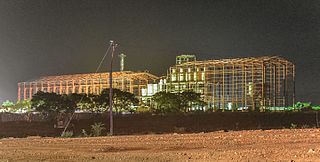
The Everglades is a natural region of flooded grasslands in the southern portion of the U.S. state of Florida, comprising the southern half of a large drainage basin within the Neotropical realm. The system begins near Orlando with the Kissimmee River, which discharges into the vast but shallow Lake Okeechobee. Water leaving the lake in the wet season forms a slow-moving river 60 miles (97 km) wide and over 100 miles (160 km) long, flowing southward across a limestone shelf to Florida Bay at the southern end of the state. The Everglades experiences a wide range of weather patterns, from frequent flooding in the wet season to drought in the dry season. Throughout the 20th century, the Everglades suffered significant loss of habitat and environmental degradation.

Clewiston is a city in Hendry County, Florida, United States. Its location is 80 miles (130 km) northwest of Fort Lauderdale on the Atlantic coastal plain. The population was 7,327 at the 2020 census, up from 7,155 at the 2010 census. It is the principal city in the Clewiston micropolitan area.

Belle Glade is a city in south-central Florida and it is the far western part of Palm Beach County, Florida, United States, on the southeastern shore of Lake Okeechobee. It is part of the Miami metropolitan area of South Florida. According to the 2020 U.S. Census, the city had a population of 16,698, down from 17,467 in the 2010 census.

Canal Point is a census-designated place (CDP) and unincorporated community in Palm Beach County, Florida, United States. It is part of the Miami metropolitan area of South Florida despite its local culture and location being way more similar to the Florida Heartland. Canal Point has a population of 344 people counted in the 2020 US census.

The South Central Florida Express, Inc. is a common carrier shortline railroad in southern Florida run by U.S. Sugar Corporation. Its trains operate from Sebring to Fort Pierce via Clewiston around the southern perimeter of Lake Okeechobee, and serves customers at 26 locations. With 171 miles (275 km) of track, the SCXF is the largest private agricultural railroad in the U.S.
Mitr Phol Group is Thailand's and Asia's biggest sugar and bio-energy producer.
Alexander & Baldwin, Inc. is an American company that was once part of the Big Five companies in territorial Hawaii. The company currently operates businesses in real estate, land operations, and materials and construction. It was also the last "Big Five" company to cultivate sugarcane. As of 2020, it remains one of the State of Hawaii's largest private landowners, owning over 28,000 acres (11,000 ha) and operating 36 income properties in the state.
The Charles Stewart Mott Foundation is a private foundation founded in 1926 by Charles Stewart Mott of Flint, Michigan. Mott was a leading industrialist in Flint through his association with General Motors.

Brazil is the world's second largest producer of ethanol fuel. Brazil and the United States have led the industrial production of ethanol fuel for several years, together accounting for 85 percent of the world's production in 2017. Brazil produced 26.72 billion liters, representing 26.1 percent of the world's total ethanol used as fuel in 2017.

The Clewiston Inn is a historic site in Clewiston, Florida, United States. It is located at U.S. 27, west of the junction with CR 832, and is the oldest hotel in the area of Lake Okeechobee. On February 21, 1991, it was added to the U.S. National Register of Historic Places.
The Fanjul family —Cuban born brothers Alfonso "Alfy" Fanjul Jr., José "Pepe" Fanjul, Alexander Fanjul, and Andres Fanjul—are owners of Fanjul Corp., a vast sugar and real estate conglomerate. It comprises the subsidiaries Domino Sugar, Florida Crystals, C&H Sugar, Redpath Sugar, former Tate & Lyle sugar companies, and American Sugar Refining. Fanjul Corp. also owns a 35% stake in Central Romana Corporation of La Romana, Dominican Republic.

Sugarcane or sugar cane is a species of tall, perennial grass that is used for sugar production. The plants are 2–6 m (6–20 ft) tall with stout, jointed, fibrous stalks that are rich in sucrose, which accumulates in the stalk internodes. Sugarcanes belong to the grass family, Poaceae, an economically important flowering plant family that includes maize, wheat, rice, and sorghum, and many forage crops. It is native to the warm temperate and tropical regions of India, Southeast Asia, and New Guinea.

An ongoing effort to remedy damage inflicted during the 20th century on the Everglades, a region of tropical wetlands in southern Florida, is the most expensive and comprehensive environmental repair attempt in history. The degradation of the Everglades became an issue in the United States in the early 1970s after a proposal to construct an airport in the Big Cypress Swamp. Studies indicated the airport would have destroyed the ecosystem in South Florida and Everglades National Park. After decades of destructive practices, both state and federal agencies are looking for ways to balance the needs of the natural environment in South Florida with urban and agricultural centers that have recently and rapidly grown in and near the Everglades.
Sugar Cane Growers Cooperative of Florida is an agricultural enterprise that harvests, transports and processes sugarcane grown primarily in Palm Beach County, Florida and markets the raw sugar and blackstrap molasses through the Florida Sugar and Molasses Exchange. The Cooperative is made up of 45 grower-owners who produce sugarcane on approximately 70,000 acres, located in the Everglades Agricultural Area (EAA). The raw sugar is marketed to one of the ASR Group's sugar refineries. The Cooperative produces more than 350,000 tons of raw sugar annually.

As of 2023, the Philippines produced 1,850,000 metric tons of sugar, ranking 17th in the world according to sugar production. In 2005, the Philippines was the ninth largest sugar producer in the world and second largest sugar producer among the Association of Southeast Asian Nations (ASEAN) countries, after Thailand, according to Food and Agriculture Organization. At least seventeen provinces of the Philippines have grown sugarcane, of which the two on Negros Island account for half of the nation's total production, and sugar is one of the Philippines' most important agricultural exports. In crop year 2009–2010, 29 sugar mills are operational, divided as follows: thirteen mills on Negros, six mills on Luzon, four mills on Panay, three mills in Eastern Visayas and three mills on Mindanao. As of crop year 2023–2024, 25 mills are operational. Of 25 sugar mills, 11 have their own sugar refineries. Among the major island groups, Visayas has the most number of operational mills with 17, 13 of which are from Negros Island alone.

The Everglades Agricultural Area Environmental Protection District, better known as simply the Everglades Agricultural Area (EAA), is an area extending south from Lake Okeechobee to the northern levee of Water Conservation Area 3A, from its eastern boundary at the L-8 canal to the western boundary along the L-1, L-2, and L-3 levees. The EAA incorporates almost 3,000 square kilometers of highly productive agricultural land. The EAA was established by the State Legislature as a special district representing landowners within the EAA Basin for the purposes of ensuring environmental protection. Means include conducting scientific research on environmental matters related to air and water and land management practices and implementing the financing, construction, and operation of works and facilities designed to prevent, control, abate or correct environmental problems and improve the environmental quality of air and water resources.

Atiak Sugar Factory Limited (ASFL), also Atiak Sugar Factory, or Atiak Sugar Limited, is a sugar manufacturing company in Uganda.

The Atlantic Coast Line Railroad's Haines City Branch was a railroad line running from their main line in Haines City, Florida south through southern Central Florida. The line notably ran through Lake Wales, Avon Park, Sebring, and Immokalee and would stretch as far south as Everglades City upon its completion in 1928. Everglades City would be the southernmost point the entire Atlantic Coast Line Railroad system would ever reach. The Haines City Branch was one of the Atlantic Coast Line's major additions to its Florida network, much of which was previously part of the Plant System.
The sugar industry of the United States produces sugarcane and sugar beets, operates sugar refineries, and produces and markets refined sugars, sugar-sweetened goods, and other products. The United States is among the world's largest sugar producers. Unlike most other sugar producing countries, the United States has both large and well-developed sugarcane and sugar beet industries. Refined sugarcane, processed sugar beet, and high-fructose corn syrup are all commonly used in the U.S. as added sugars to sweeten food and beverages.

U.S. Sugar 148, formerly Florida East Coast 148, is a 4-6-2 steam locomotive built in April 1920 by American Locomotive Company (ALCO) of Richmond, Virginia, originally for the Florida East Coast Railway (FEC). It hauled passenger and freight trains between Jacksonville and Miami, Florida, including FEC's Overseas Railroad to Key West, Florida until the line was destroyed in 1935. The locomotive was sold in 1952 to U.S. Sugar Corporation (USSC) to haul sugarcane trains in Clewiston, Florida.















